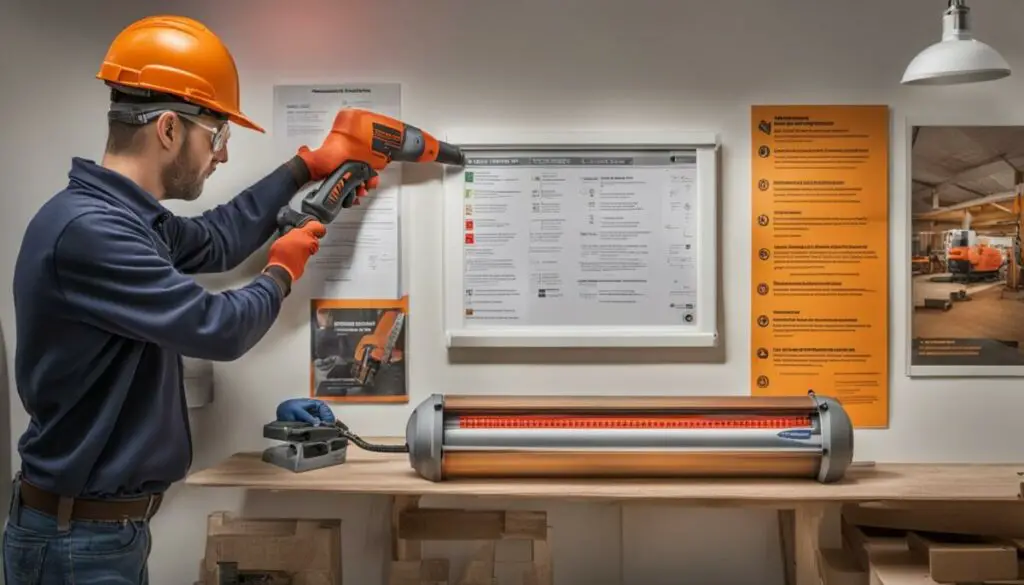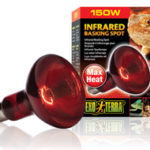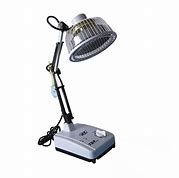Last Updated on 5 months by Francis
Looking for a safe and efficient heating solution? Infrared heaters might be just what you need. But before you make a decision, it’s important to understand their safety aspects. Are infrared heaters safe? Let’s find out.
Contents
Key Takeaways
- Infrared heaters provide safe and natural warmth by emitting infrared heat.
- Infrared radiation is completely safe for use, unlike more dangerous types of radiation.
- They heat objects and people directly, making them highly efficient in converting energy into usable heat.
- Infrared heaters come with various safety features, such as fire-resistant coatings and overheat protection.
- It is important to follow safety guidelines and take necessary precautions for safe usage.
Understanding Infrared Heat and How It Works
Infrared heat is a natural process that we experience daily, from the warmth of an open fire to the heat our bodies emit. Infrared heaters use electromagnetic radiation to produce heat, which is absorbed by objects and people in its path. This direct heating method makes infrared heaters more efficient and faster at warming up spaces compared to traditional heaters that rely on heating the air.
One of the key benefits of using infrared heaters is their ability to provide targeted warmth. Instead of heating the air in a room, infrared heaters emit infrared radiation that directly heats objects and people within their range. This mimics our natural body heat, creating a comfortable and cozy environment. In addition, infrared heaters can be more energy-efficient than other types of heaters because they don’t waste energy heating the entire room.
When comparing infrared heaters to other types, such as convection heaters and radiant heaters, the advantages of infrared heat become more apparent. Unlike convection heaters that rely on the circulation of heated air, infrared heaters offer faster and more efficient heating. Radiant heaters emit a broader range of electromagnetic waves, while infrared heaters deliver focused warmth. This targeted heat can be especially beneficial in larger rooms or areas where people gather, as it allows for customizable comfort in specific spots.
Safety Features of Infrared Heaters
Infrared heaters are designed with various safety features to ensure safe and worry-free usage. These features provide added protection and peace of mind, making infrared heaters a safe choice for heating your space. Here are some of the key safety features you can expect from infrared heaters:
Overheat Protection
One of the important safety features found in infrared heaters is overheat protection. This feature is designed to automatically shut off the heater if the internal temperature rises above a safe level. It helps prevent the risk of overheating and potential damage to the heater or surrounding objects.
Tip-Over Shut-Off
Many infrared heaters are equipped with a tip-over shut-off feature. This safety mechanism ensures that if the heater is accidentally knocked over or tilted, it will automatically turn off to prevent accidents or fires. This is especially important in households with children or pets, providing an extra layer of safety.
Splash-Proof Design
Some infrared heaters have a splash-proof design, indicated by their IP rating. This means they are resistant to splashes of water, making them suitable for use in areas where there may be moisture or the risk of water exposure. The splash-proof design adds an extra level of safety, especially in bathrooms, garages, or outdoor spaces.
Smart Control Features
Advanced infrared heaters are equipped with smart control features that allow for easy and convenient heat management. These features can include temperature settings, timers, and remote control capabilities. By providing precise control over the heating process, smart control features ensure safe and efficient usage of the heater.
Fire-Resistant Coatings
Some infrared heaters are designed with fire-resistant coatings, which provide an additional layer of safety in case of accidental contact with flammable materials. These coatings help reduce the risk of fire and make the heater safer to use in various environments.
Usage Guidelines
While infrared heaters come with safety features, it is important to follow usage guidelines to ensure their safe operation. Avoid placing flammable objects near the heater, maintain a safe distance from furniture or walls, and ensure proper ventilation in the room. Additionally, always read and follow the manufacturer’s instructions for specific safety recommendations.
By utilizing the safety features and following the usage guidelines, you can enjoy the effective and comforting warmth of infrared heaters with peace of mind.
| Safety Features | Description |
|---|---|
| Overheat Protection | Automatically shuts off the heater if the internal temperature rises above safe levels. |
| Tip-Over Shut-Off | Turns off the heater if it is accidentally knocked over or tilted to prevent accidents or fires. |
| Splash-Proof Design | Resistant to splashes of water, making them suitable for use in areas with moisture or water exposure. |
| Smart Control Features | Allows for easy and convenient heat management through temperature settings, timers, and remote control capabilities. |
| Fire-Resistant Coatings | Reduces the risk of fire in case of accidental contact with flammable materials. |
Infrared Heaters and Health Risks

When it comes to infrared heaters, one of the common concerns is whether they are safe to use and if they pose any health risks. It’s important to understand that infrared radiation, the type of radiation emitted by these heaters, is different from more harmful types such as gamma or UV radiation. In fact, infrared radiation is similar to visible light and does not have the same negative effects on our health.
Unlike traditional heaters that warm up the surrounding air, infrared heaters work by directly heating objects and people in their path. This targeted heating method means that the air in the room does not get excessively heated, minimizing the risk of dryness or discomfort. However, it is still important to practice normal safety precautions when using infrared heaters.
Avoiding prolonged exposure to the direct infrared heat is recommended. This means not sitting too close to the heater for extended periods of time and avoiding staring directly into the heat source. By maintaining a safe distance and following these simple guidelines, you can enjoy the warmth and energy efficiency of infrared heaters without any significant health risks.
Common Concerns about Infrared Heaters
Some common concerns about infrared heaters revolve around their potential effects on our health. However, it’s important to separate fact from fiction and understand the science behind these heaters. Infrared radiation is a natural form of heat that we experience in our daily lives, and it is not known to cause any adverse health effects when used responsibly.
Infrared heaters are designed to emit safe levels of radiation and come with various safety features to ensure their proper use. For instance, many infrared heaters have built-in overheat protection, which automatically shuts off the heater if temperatures exceed safe limits. Additionally, some models have fire-resistant coatings and splash-proof ratings, making them suitable for use in areas exposed to water.
By using infrared heaters responsibly, following safety guidelines, and taking advantage of the built-in safety features, you can enjoy the benefits of efficient and targeted warmth without compromising your health or safety.
Types of Infrared Heaters

Infrared heaters come in various types, each offering unique features and benefits. Understanding the different types can help you make an informed decision when purchasing an infrared heater for your specific needs.
1. Natural Gas Infrared Heaters
Natural gas infrared heaters are a popular choice for outdoor heating applications. They are fueled by natural gas and provide powerful and efficient heating for patios, garages, and other outdoor spaces. These heaters often come with adjustable settings for heat intensity and have a wide heating range.
2. Vent-Free Infrared Heaters
Vent-free infrared heaters are designed for indoor use and do not require any venting or chimney installation. They are fueled by propane or natural gas and are easy to install. Vent-free heaters are highly efficient, providing instant and targeted warmth, making them suitable for small spaces like bedrooms or living rooms.
3. Electric Infrared Heaters
Electric infrared heaters are powered by electricity and are ideal for both indoor and outdoor use. They are easy to install and operate, requiring only a power outlet. Electric infrared heaters offer instant and consistent warmth, making them suitable for various spaces, including bedrooms, offices, and outdoor patios.
4. Wall-Mounted Infrared Heaters
Wall-mounted infrared heaters are space-saving options that can be easily mounted on walls or ceilings. They provide efficient heating and are suitable for rooms with limited floor space. Wall-mounted heaters are often adjustable and come with remote control for convenient operation.
5. Propane Gas Infrared Heaters
Propane gas infrared heaters are portable and versatile options that are fueled by propane gas. They are commonly used for outdoor heating, camping, or construction sites. Propane gas heaters provide instant and efficient heating and are easy to transport from one location to another.
When choosing an infrared heater, consider factors such as the intended use, heating capacity, and energy efficiency. It’s important to select a heater that suits your specific needs and provides optimal warmth and comfort.
Advantages of Using Infrared Heaters

Infrared heaters offer several benefits that make them a popular choice for heating spaces. Here are some advantages of using infrared heaters:
- Energy Efficiency: Infrared heaters provide direct heat to objects and people, rather than heating the air. This targeted heating method makes them more energy-efficient compared to traditional heaters that rely on warming the entire room. By heating objects directly, infrared heaters can quickly warm up a space without wasting energy.
- Instant Warmth: Unlike some traditional heaters that take time to warm up the air, infrared heaters deliver instant warmth as soon as they are turned on. This makes them ideal for situations where immediate heat is needed, such as during chilly mornings or in drafty areas.
- Quiet Operation: Infrared heaters operate silently, without the noise often associated with fan-forced heaters. This makes them perfect for use in bedrooms, offices, and other areas where a quiet environment is desired.
- Portability and Versatility: Many infrared heaters are lightweight and come with convenient handles or wheels, making them easy to move around and install in different spaces. Whether you need to heat a specific room, an outdoor patio, or a garage workshop, infrared heaters can be easily transported and set up wherever heat is needed.
- Reduced Energy Consumption: By directly heating objects and people instead of the air, infrared heaters can help reduce energy consumption. This targeted heating method allows you to comfortably lower the thermostat in your home without sacrificing warmth, resulting in potential energy savings.
In summary, infrared heaters provide energy-efficient, instant warmth with quiet operation. Their portability and versatility make them suitable for various heating needs, while their targeted heating method can help reduce energy consumption. With these advantages, it’s no wonder why more and more people are choosing infrared heaters as a reliable and efficient heating solution.
Comparing Infrared Heaters to Other Types

Infrared heaters have become increasingly popular as a heating solution due to their unique characteristics and benefits. Let’s explore how they compare to other types of heaters.
Benefits of Infrared Heaters
Infrared heaters provide several advantages over traditional convection and radiant heaters. Unlike convection heaters, which rely on heating the air, infrared heaters emit infrared radiation that directly heats objects and people in its path. This targeted warmth results in faster and more efficient heating, as well as reduced energy consumption.
Compared to radiant heaters, which emit a broad range of electromagnetic waves, infrared heaters emit only infrared radiation. This means that they provide more focused and comfortable warmth without drying out the air or producing excessive heat. Additionally, infrared heaters operate quietly and can be easily moved or installed in different spaces.
Comparisons with Other Heaters
When comparing infrared heaters with other types, such as convection heaters and radiant heaters, the key differences lie in their heating mechanisms and efficiency.
| Type of Heater | Heating Mechanism | Efficiency |
|---|---|---|
| Infrared Heaters | Emit infrared radiation to heat objects and people directly | Highly efficient due to targeted warmth |
| Convection Heaters | Warm the air which then circulates to heat the surroundings | Less efficient as energy is used to heat the air |
| Radiant Heaters | Utilize electromagnetic waves to provide warmth | Efficiency varies depending on the specific type |
While all types of heaters have their own advantages and applications, the targeted warmth and energy efficiency offered by infrared heaters make them a popular choice for those seeking efficient and comfortable heating solutions.
Safety Precautions for Infrared Heater Usage

When using infrared heaters in your home or office, it is important to follow certain safety precautions to ensure safe and effective operation. By following these guidelines, you can enjoy the warmth and comfort of an infrared heater while minimizing the risk of accidents or hazards.
Positioning and Placement
Placement is crucial when using an infrared heater. Keep flammable materials such as curtains, furniture, and clothing at a safe distance from the heater. Ensure that there is ample space around the heater to allow for proper ventilation. It is also advisable to position the heater away from high-traffic areas and where it cannot be easily knocked over. Additionally, avoid placing the heater on uneven surfaces to prevent tipping.
Electrical Safety
When plugging in your infrared heater, make sure to use a dedicated electrical outlet and avoid overloading it with other appliances. It is essential to inspect the power cord for any signs of damage and refrain from using the heater if the cord appears frayed or worn. Avoid running the power cord under carpets or rugs as it can cause overheating. Regularly check the outlet and cord for overheating during use.
Manufacturer’s Guidelines
Always read and follow the manufacturer’s instructions and guidelines for your specific infrared heater model. The manufacturer’s guidelines will provide detailed information on safe usage, recommended distances, and any additional precautions specific to your heater. Adhering to these guidelines will help ensure the safe and optimal operation of your infrared heater.
| Safety Precautions | Guidelines |
|---|---|
| Positioning and Placement | Keep flammable materials at a safe distance. Position heater away from high-traffic areas and uneven surfaces. |
| Electrical Safety | Use a dedicated outlet. Inspect power cord for damage. Avoid running the cord under carpets or rugs. |
| Manufacturer’s Guidelines | Read and follow the instructions provided by the manufacturer for your specific heater model. |
By following these infrared heater safety precautions and usage guidelines, you can enjoy the warmth and convenience of an infrared heater with peace of mind. Remember to prioritize safety in order to create a comfortable and hazard-free environment for yourself and those around you.
Safety Features of Infrared Heaters

Infrared heaters come equipped with a range of safety features to ensure the well-being of users and minimize potential risks. These safety features are designed to provide peace of mind and promote safe usage of infrared heaters. Here are some key safety features to look out for:
Overheat Protection
One of the crucial safety features of infrared heaters is overheat protection. This feature automatically shuts off the heater if it reaches a temperature that exceeds the safe limit. By preventing overheating, it reduces the risk of fire hazards and potential damage to the heater. Overheat protection ensures safe and worry-free usage, especially when leaving the heater unattended or using it for extended periods.
Tip-Over Shut-Off
Another important safety feature is the tip-over shut-off mechanism. This feature detects if the heater is accidentally knocked over or tilted and cuts off the power supply to prevent accidents or fires. It adds an extra layer of safety, particularly in households with children or pets. With the tip-over shut-off feature, you can have peace of mind knowing that the heater will automatically turn off if it is not in an upright position.
Child Lock
Some advanced infrared heaters also come with a child lock feature that prevents unintended changes to the heater’s settings. This feature is particularly useful in homes with curious children who may unintentionally adjust the temperature or other settings. The child lock feature ensures that the heater continues to operate at the desired settings without any accidental modifications.
Timer and Auto-Shutoff
Many infrared heaters are equipped with timer functions and auto-shutoff capabilities. These features allow you to set a specific operating time for the heater, ensuring that it does not run indefinitely. Once the set time elapses, the heater automatically shuts off, preventing unnecessary energy consumption and ensuring safe usage. The timer and auto-shutoff features also provide convenience and energy savings, allowing you to program the heater according to your specific heating needs.
Infrared Heater Installation and Maintenance

Proper installation and maintenance of infrared heaters are crucial for safe and efficient usage. When installing your infrared heater, it is essential to ensure correct electrical wiring to avoid any potential hazards. Make sure to follow the manufacturer’s guidelines and recommendations for proper installation. Avoid covering the wires or overloading the electrical outlet to prevent any risks of electrical fires.
Regular maintenance is also necessary to keep your infrared heater running smoothly. It is recommended to clean your heater regularly to remove any dust or debris that may accumulate on the surface or inside the unit. Use a soft cloth or brush to gently clean the exterior and carefully remove any dirt from the heating elements. Regular inspection of your heater is important to identify any potential issues or malfunctions. If you notice any unusual smells, noises, or performance changes, it is advisable to contact a professional technician for further inspection.
Quick Tips for Infrared Heater Installation and Maintenance:
- Follow the manufacturer’s guidelines for proper installation
- Avoid covering wires and overloading electrical outlets
- Clean the heater regularly to remove dust and debris
- Inspect the heater for any issues or malfunctions
- Contact a professional technician for assistance if needed
“Proper installation and regular maintenance are essential for safe and efficient usage of infrared heaters.”
By ensuring the correct installation and regular maintenance of your infrared heater, you can enjoy its benefits while maintaining a safe environment. Following these guidelines and taking necessary precautions will help keep your infrared heater operating at its best and protect against potential hazards. Remember to consult the manufacturer’s instructions and seek professional assistance when needed. With proper care, your infrared heater can provide reliable and efficient heating for years to come.
Are Infrared Heaters Safe for Overnight Use?
Many people wonder if it is safe to leave infrared heaters on overnight, given their unique heating technology. While infrared heaters are generally safe for extended use, it is important to consider certain factors and follow safety precautions to ensure a safe environment.
Infrared heaters are designed with safety features such as overheat protection and tip-over shut-off, which help minimize potential risks. These features automatically turn off the heater if it exceeds safe temperature limits or if it is accidentally knocked over, reducing the risk of fire or accidents.
When using an infrared heater overnight, it is advisable to set the temperature to a lower level and ensure proper ventilation in the room. This will help maintain a comfortable and safe environment while preventing any potential hazards associated with prolonged use.
It is also crucial to follow the manufacturer’s guidelines and recommendations for safe usage. These instructions may include keeping a safe distance between the heater and other objects, avoiding the use of flammable materials near the heater, and ensuring proper electrical safety to prevent fires.
By understanding and adhering to these safety precautions, infrared heaters can be used overnight with confidence, providing a reliable and efficient heating solution. However, it is always important to exercise caution and prioritize safety when using any heating device.
Conclusion
In conclusion, infrared heaters are a safe and reliable option for providing warmth in various spaces. With their ability to emit infrared heat, these heaters offer targeted warmth that is efficient and effective. By heating objects and people directly instead of relying on heating the air, infrared heaters ensure energy efficiency and cost savings.
When using infrared heaters, it is important to follow a few safety tips to ensure safe usage. Keep a safe distance between the heater and flammable objects, furniture, or walls. Read and follow the manufacturer’s guidelines and usage instructions. Regularly clean and inspect the heater for any potential hazards or malfunctions.
Overall, infrared heaters are safe to use with the proper precautions in place. Their benefits, such as energy efficiency and targeted warmth, make them a popular choice for both indoor and outdoor heating needs. By understanding how infrared heaters work and taking necessary safety measures, you can confidently enjoy the comfort and warmth they provide.
FAQ
Are infrared heaters safe to use?
Yes, infrared heaters are safe to use. They emit a type of radiation called infrared heat, which is completely safe and natural.
How do infrared heaters work?
Infrared heaters emit infrared radiation, which heats objects and people directly instead of heating the surrounding air. This makes them more efficient at warming up spaces compared to traditional heaters.
What safety features do infrared heaters have?
Infrared heaters come with features like overheat protection and tip-over shut-off to ensure safe usage. Some models also have fire-resistant coatings and in-built protection against overheating.
Do infrared heaters pose any health risks?
No, infrared heaters do not pose significant health risks. The type of radiation they emit is similar to visible light and different from more harmful types of radiation like x-rays or UV rays.
What types of infrared heaters are available?
There are various types of infrared heaters, including natural gas, vent-free, electric, wall-mounted, and propane gas heaters. Each type has its own advantages and suitability for different spaces.
What are the advantages of using infrared space heaters?
Infrared space heaters provide energy-efficient heating by directly warming objects and people. They deliver instant warmth, operate quietly, and can be easily moved or installed in different spaces.
How do infrared heaters compare to other types of heaters?
Infrared heaters offer faster and more efficient heating compared to convection heaters and radiant heaters. They emit targeted warmth, while radiant heaters have a broader range of electromagnetic waves.
What safety precautions should I take when using infrared heaters?
It is important to avoid placing flammable objects near the heater, maintaining a safe distance from furniture or walls, and following the manufacturer’s guidelines. Regular cleaning and inspection are also recommended.
What are overheat protection and tip-over shut-off?
Overheat protection automatically shuts off the heater if temperatures exceed safe limits, while tip-over shut-off cuts off the power supply if the heater is accidentally knocked over. These features enhance safety while using infrared heaters.
How should I install and maintain an infrared heater?
Proper installation includes correct electrical wiring, avoiding covering the wires, and not overloading the electrical outlet. Regular cleaning and inspection of the heater are important for safe usage.
Can I leave infrared heaters on overnight?
While infrared heaters are generally safe for overnight use, it is recommended to follow the manufacturer’s guidelines and ensure proper ventilation in the room. It is important to maintain a safe environment and avoid prolonged exposure to the direct infrared heat.









